
White Paper
Arista Cognitive Campus Network
Table of Contents
– Extending to the Campus
– Real-Time Telemetry
– Cognitive Campus Network
– Cognitive Campus Platforms
– Splines for Collapsed Single-Tier Fabric
– Cognitive Wi-Fi Edge
– Cognitive Arista EOS
– Cognitive Management Plane
– Campus Use Cases
– The Next Frontier
Campus networks are undergoing a massive transition to handle unprecedented challenges, as enterprises move to IoT-ready campuses. Indeed, network architects face a new mandate to better align with morphing business needs and ubiquitous user workloads, using open software-driven cloud principles for a consistent, uniform enterprise-wide operational experience. The 1990s saw the challenge of information sharing via the internet and email. The 2000s marked the convergence of business systems and PBX networks, improving productivity and lowering operational costs. The unfolding decade marks another fundamental transition where administrators face a confluence of challenges ranging from an interconnected IoT (Internet of Things) environment and older firewall boundaries to shifting workloads, sprawling user bases, and a complex mix of diverse operating systems and network management tools amidst ever-increasing security concerns. Consequently, network architects face critical questions in this age of an IoT-ready campus: How to scale IT operations without increasing operational expenses? What is the impact on the network as workloads shift to advanced cloud environments? For organizations that consider IT a competitive advantage, Arista offers cloud class solutions with industry-leading merchant silicon architectures, all running a single image of its Extensible Operating System, EOS®. Indeed, Arista has emerged as a cloud networking pioneer and leader, providing customers visibility and programmability across their physical and virtual networks with best-of-breed reliability and automated operations.
Extending Cloud Grade Principles to the Campus
Arista’s latest innovations drive campus networks to the cognitive cloud age, replacing the over-subscribed legacy three-tier model of access-aggregation-core. Specifically, the campus network is rapidly evolving from siloed box-based places in the network (PINs) to places in the cloud (PICs). End users and network designers expect similar benefits from modern campus networks that they currently derive from Arista’s Universal Cloud Network (UCN) of uniform single-tier cognitive Spine-Leaf based data centers. These advantages including high scalability, reliability, automated traffic visibility, and security have to be present in the campus as well for a seamless Client-to-Cloud environment. The challenge, however, lies in successfully transitioning the existing siloed campus into an integral place in the cloud, while addressing security and availability needs with lower operational costs. The key requirements of the third-generation evolution are shown below in Figure 1.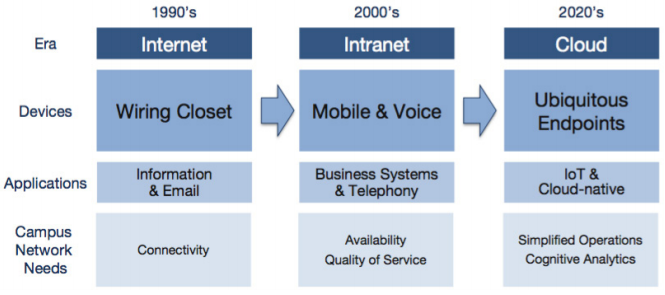
Figure 1:
The New Frontier in Campus Networking Evolution
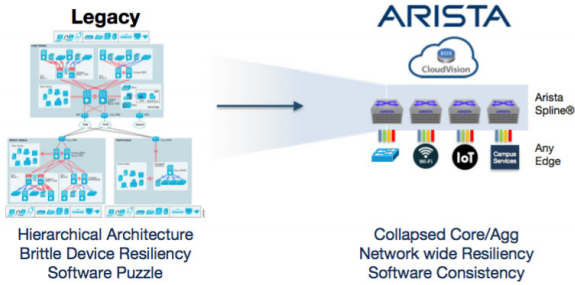
Figure 2:
Three Tiers Versus Single Tier Collapsed Spine or SplineTM
Real-Time Telemetry
Campus designers should also implement network telemetry and statistics, rather than merely count bytes and drops. Monitoring on-board queues for congestion, latency and other flow statistics would help administrators address network hot spots before users are impacted. Of course, innovations in telemetry must be matched with advances in monitoring systems. Even at five second intervals, polling is too slow and limited in the new world of cloud and campus sprawl. In contrast to legacy schemes, cognitive cloud-based telemetry combines near real-time streaming telemetry with big data analytics as shown in Figure 3. Open schemes such as OpenConfig or gNMI use standard APIs to quickly and efficiently deliver a wealth of streaming information. Publish subscribe exchange models are inherently more efficient and adaptable because only information updates are shared. The shared data model is also more advanced, providing both data definition or keys, along with data values. Together, this scheme greatly reduces telemetry processing and network load.| Table 1: Legacy vs Modern Telemetry | |
|---|---|
| Traditional / Legacy Approach | Campus Telemetry Requirements |
1990’s Networking |
Campus DC Architectures |
Polling Approach (10-15 min) |
Real-time Streaming |
State Scope Limited to MIB Definition |
Complete State History |
Per-Switch, Per Device |
Network-wide Scope |
Static, Discrete Events. Manually Correlated |
Dynamic Event Correlation |
While many networking companies understand the value of telemetry and analytics, few have architected analytics to create, stream and process networking data effectively.
Arista’s Cognitive Campus Network
Arista’s vision and framework for the Cognitive Campus Network leverages cloud capabilities and state of the art merchant silicon to deliver critical services that automate deployment, configuration, visibility troubleshooting and security. The Arista Cognitive Campus consists of three building blocks: Spline platforms, Cognitive Management Plane and cognitive features based on single image EOS as shown in Figure 3.Cognitive Campus Portfolio
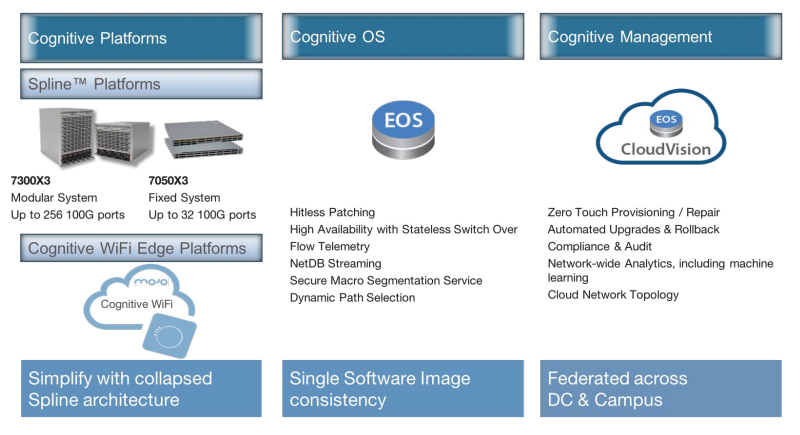
Figure 3:
Arista Cognitive Campus - Spline Platforms, EOS features and Cognitive Management Plane based on CloudVision
-
Splines for Collapsed Single-Tier Fabric
Arista has uniquely expanded cloud grade capabilities for the campus with the modular 7300X3 and fixed 7050X3 platforms. These spline platforms are designed to provide a suite of cognitive actions and features for high availability and simplicity. Self-healing, hitless upgrades and live patching are cognitive actions that minimize or outright avoid impact on the user. Arista’s Smart System Upgrade (SSU) feature enables switch operating software to be completely upgraded while the platform continues to process workgroup traffic. Arista’s Spline advantage is based on a uniform performance with balanced forwarding tables, and dynamic buffers, while coping with the proliferation of mobile, diverse and bursty traffic generated by campus users and devices. Salient EOS features and their benefits enhancing the cognitive campus are listed below in Figure 4.
The X3 series provides a variety of connectivity options: 1-10G and 25G SFP+, 40G, 50G and 100G QSFP. These platforms support dynamic buffer allocation available to all networked ports to help avoid data loss due to congestion or micro-bursts. The Splines work with all devices that support static or dynamic port aggregation so that installed base investment is preserved. The X3 series is also designed to accommodate a variety of layer 2 and 3 scaling demands with the help of its dynamically configurable Unified Forwarding Table (UFT). Unlike other static architectures with fixed L2 MAC and L3 routing tables, the X3 platforms let administrators select from multiple profiles optimized for either L2 MAC addressing, L3 host addressing or IPV4-6 route table scale. This simplifies design considerations because a common platform can be optimized for various campus use cases. Consistent with other Arista platforms, the X3 series supports wire speed L2 VLAN, L3 routing and L2 over L3 VXLAN that transcends 4K vlans to more than 16.7 million industry standard VXLAN virtual networks. Campus-wide dynamic grouping and segmentation of workgroups is accomplished through EVPN services in conjunction with Cloudvision options. The X3 series is well suited as the single tier fabric combining traditional aggregation and core layers into a collapsed Spline.
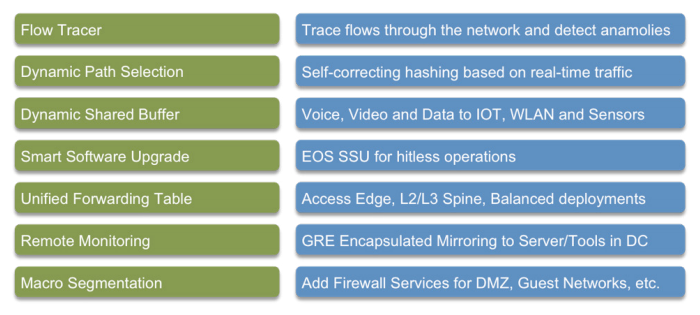
Figure 4:
Key Attributes of Cognitive Campus Splines and EOS -
Cognitive Wi-Fi Edge
Arista entered the wireless LAN market with a portfolio of Wi-Fi edge products through acquisition of cognitive Wi-Fi pioneer, Mojo Networks in 2018. Arista now extends the cognitive campus providing secure (WIPS) multi-gigabit cognitive Wi-Fi at cloud scale for device connectivity. The new generation of software-based Wi-Fi is disrupting the traditional closed wireless controller model, to bring radical improvements in scale and economics with AI and machine learning software. Cognitive Wi-Fi was born in the cloud continues to innovate modern, advanced solutions for the enterprise. Mojo has won acclaim in the Gartner Magic Quadrant in 2018 as a visionary with four other vendors. -
Cognitive Arista EOS
Arista EOS provides a common foundation for the cognitive campus network. The transformational Extensible Operating System (EOS) brings its baseline advantages to the campus with cloud grade control, monitoring, virtualization, scale and reliability. Arista’s unique self-healing architecture isolates software bugs, supports live patching and redefines hitless upgrade and rollback.The same binary EOS image is used across Arista’s entire product line. Therefore EOS quality and reliability is consistently validated across various workloads in both datacenter and campus networks, worldwide. Open standard APIs in EOS support industry leading DevOps, monitoring solutions. Core to Arista’s EOS architecture is NetDB: the network-wide, state-driven, publish-subscribe-notify database. Unlike legacy polling or inter-processor communication (IPC) schemes, NetDB is purpose-built to share all state in real time. Streaming or real-time data is complete and efficient, communicating thousands of state changes at sub-second intervals to monitoring platforms using open JSON over HTTP. Implementing dynamic JSON dictionaries means NetDB can evolve, sharing new, additional key/value information to monitoring tools. A key EOS capability provides real-time flow tracking features that can report network congestion and degradation of workflows before traffic is lost, and users’ applications are impacted. This Flow Tracer feature identifies critical spots and manages congestion hop-by-hop with options to append time stamping, device identity and queue depth. Another cognitive behavior of EOS is the employment of advanced dynamic load balancing (DLB) to optimize performance of load sharing links. DLB enhances campus network performance by monitoring both flow and bandwidth distribution across platforms, iteratively balancing and maximizing link utilization across splines and leafs. -
Cognitive Management Plane
Within the industry there is a striking contrast between the maturity and robustness of the data and control planes, and a void at the management plane. At Arista, CloudVision incorporates our cornerstone Cognitive Management Plane (CMP) to automate deployments, simplify monitoring, anticipate errors, and avoid outages across all Arista platforms in real time. CloudVision harnesses the capabilities of cloud computing, big data, and machine learning, collecting and archiving all network state over all time. CloudVision’s Cognitive Management Plane ingests all streaming state from EOS platforms while its open APIs allow data sharing with other applications, either custom developed or from third parties. This allows administrators the flexibility to use best-of- breed tools for data-driven actions and analysis. The Cognitive Management Plane’s API conveys commands as well as telemetry to allow configuration management tools to control the campus infrastructure. Together with NetDB’s schema and APIs which parallel OpenConfig APIs, CMP enables customer’s requirements for standards, openness and flexibility with flexible management and actions as depicted in Figure 5.
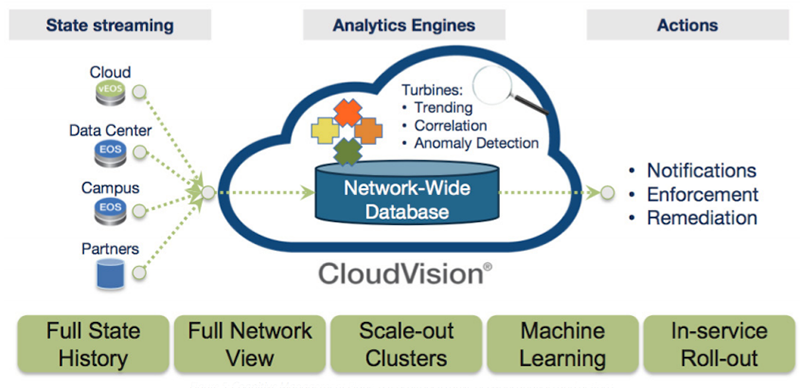
Figure 5:
Cognitive Management Plane, a Repository to Drive Network Analysis and Actions
- State history: Operators can see all state of any device from any point in time. Historical visibility is a big help in debugging transient or intermittent issues.
- Network view: Arista CloudVision fully supports all Arista products. We expect other vendors to add support for their devices in their management plane clusters or via OpenConfig APIs.
- High availability: CMP clusters co-ingest state from the same set of devices, such that if a node in the cluster fails, the cluster continues to manage devices.
- Machine learning: CMP supports machine learning algorithms to automatically identify alerts that are important for likely root causes of anomalous behavior.
- In-service roll-out: Because the management plane is independent from the managed devices control plane, CloudVision can be maintained independent of the physical infrastructure. The management plane doesn’t affect applications; hence, management plane upgrades are low risk, and new features can be deployed frequently.
- Multi-vendor scalability: Third parties can provide their own CMP and offer their unique benefits to customers. Multiple CMP clusters can be replicated and distributed to better serve organizational or geographic domains.
- Cross-cluster awareness: Through state export, an application can run in one cluster based on state in other clusters.
Cognitive Client to Campus Use Cases
As campus networks transform to support the latest frontier, many examples and use cases are emerging:- Flow tracking to pinpoint hotspots
- Dynamic load balancing to alleviate congestion
- Improved security from audit to segmentation
- Enhanced client to cloud automation
Here are a few examples:
1. Cognitive Use Case: Intelligent MonitoringCampus Spline platforms deliver real-time flow tracking and dynamic load balancing with a wealth of device and traffic information available to better discern workflows in the cognitive campus network. Device ID and port connections can be correlated to sampled flow data and other hardware-based flow telemetry to identify and rectify degradation. Administrators can use this data to pinpoint network hotspots and make adjustments before user applications are adversely impacted, and balance links based on workload and traffic.
2. Cognitive Use Case: Secure Segmentation
Leveraging flow data to better secure campus networks is a critical element of the cognitive campus network. With behavior-driven workflow data, administrators can employ various standards-based network segmentation technologies to isolate suspicious workflows. Unlike complex, proprietary segmentation schemes, open, standards-based 802.1q and VXLAN-based EVPN segmentation services can be combined to isolate suspect workflows or critical workloads across a campus-wide, multivendor environment.
For outlier workflows, CloudVision provides traffic steering and segmentation capabilities in its Macro Segmentation Services (MSS) feature set. The campus is dynamically configured to enforce security policy with no impact to other workloads. This simplifies campus network administration, and helps automate security enforcement using standard traffic segmentation technologies.
3. Cognitive Use Case: Compliance and Audit Control
DevOps solutions have proven their worth in countless datacenters for both server and network administration. When used to manage uniform software platforms, DevOps systems have a proven record of reducing errors while improving deployment time. Yet even in DevOps, there are opportunities for data analytics to further reduce TCO. Databases of systems configurations can be checked against bug databases to identify and warn administrators of possible vulnerabilities before they become outages. Cognitive compliance checking is better when configurations and operating systems are uniform and consistent, particularly in a sprawling campus. CloudVision’s Compliance dashboard helps perform cognitive audits. Systems configurations and running OS images are compared against Arista’s bug tracker database to identify possible compliance issues as depicted in Figure 7. This forewarns administrators of potential vulnerabilities and offers remediation options before a catastrophic incident. CloudVision’s proactive visibility of pre- and post-differentials for VLANs, MAC or route metric adds additional and valuable audit control.
| Table 2: Cognitive Checking Simplifies Compliance Decisions | ||
|---|---|---|
| Feature / Bug / OS Baseline | Installed OS | Targeted OS |
OS PSIRT |
✓ |
✓ |
Integrated Patches |
♦ |
✓ |
Implemented L2 features |
N/A |
N/A |
Implemented L3 features |
♦ |
✓ |
Implemented Overlay features |
✓ |
✓ |
4. Cognitive Use Case: Zero Touch Automation
There is an ever-increasing frustration with the inconsistent quality of legacy datacenter networks. Campus administrators struggle to manage user’s traffic from computers and smartphones, and are now additionally faced with critical campus IoT traffic from badge readers, security cameras and environmental controllers, just to name a few. The challenge of securing and protecting information is paramount, but extreme measures may degrade or outright break legitimate applications. Lastly, the complexities of maintaining installed legacy infrastructure can be its own full-time job as managers must certify discrete platform images for different parts of their multi-tiered network.
Extending Cloud Networking principles, Arista Cognitive Campus Architecture is designed to address users’ and administrators’ needs with automated end-to-end configuration builder and orchestration services shown in Figure 6 below.
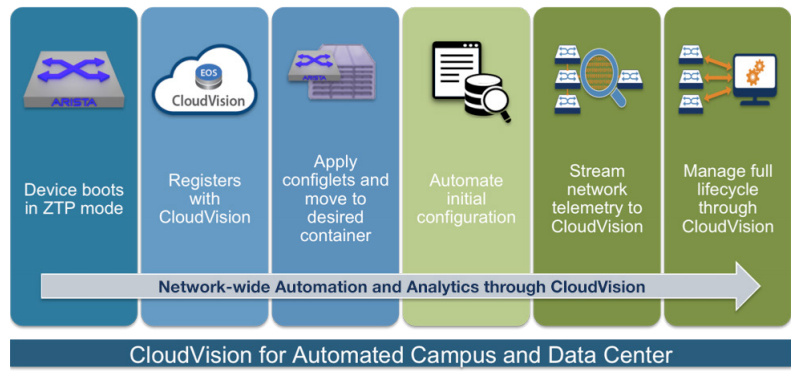
Figure 6:
Prudent Automation Steps from Client to Cloud
The Next Frontier in Campus
Arista’s Splines, EOS and CloudVision, based on a breakthrough Cognitive Management plane, are designed to deliver the next generation campus for our customers. They provide a simplified, secure and automated experience. Arista is raising the bar, delivering cloud grade DNA to the campus. The explosion of users, IOT devices and bursty traffic requires thoughtful campus migration. Designs must evolve from brittle complexity to uniform networking and lower TCO. The contrast is clear between today’s intent-based network implying hope or hype, versus Arista’s pragmatic cognitive-driven actions. With Arista’s cloud grade and cognitive campus platforms, network leaders and IT managers can realize their multi-year journey and start their planning now.Copyright © 2018 Arista Networks, Inc. All rights reserved. CloudVision, and EOS are registered trademarks and Arista Networks is a trademark of Arista Networks, Inc. All other company names are trademarks of their respective holders. Information in this document is subject to change without notice. Certain features may not yet be available. Arista Networks, Inc. assumes no responsibility for any errors that may appear in this document. May 7, 2018 · 02-0078-02
